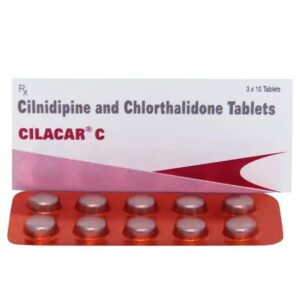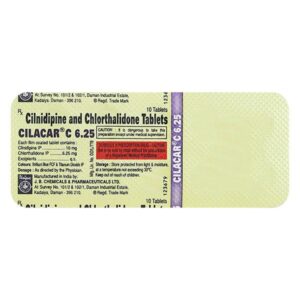CHLORTHALIDONE + CILNIDIPINE
Chlorthalidone: Chlorthalidone is a medication classified as a thiazide-like diuretic. It is commonly prescribed to treat high blood pressure and fluid retention (edema) in conditions such as congestive heart failure or kidney disorders.
The exact mechanism of action of chlorthalidone is not fully understood, but it is believed to work by increasing the excretion of sodium, chloride, and water through the kidneys. This leads to reduced fluid volume in the body, resulting in lower blood pressure.
The dosage of chlorthalidone depends on the condition being treated and individual patient factors. Typically, the initial dose for hypertension is 25 mg to be taken orally once per day, which may be increased if necessary. For edema, the starting dose is 50 to 100 mg daily, which may be adjusted as per the patient’s response.
Like other medications, chlorthalidone may have side effects. Common side effects include dizziness, lightheadedness, headache, increased urination, and muscle cramps. Others may experience gastrointestinal disturbances such as nausea, vomiting, or diarrhea. It may also cause electrolyte imbalances, resulting in low levels of potassium, sodium, or magnesium in the blood. These imbalances can lead to symptoms such as muscle weakness, irregular heartbeat, or excessive thirst.
It is important to note that chlorthalidone can interact with other medications, so it is essential to inform your healthcare provider about all the medications you are taking to prevent potential drug interactions.
Overall, chlorthalidone is an effective medication for the treatment of hypertension and edema, but it should only be used under the guidance of a healthcare professional, who will carefully monitor its use and potential side effects.
Cilnidipine: Cilnidipine is a calcium channel blocker drug that is primarily used for the management of hypertension (high blood pressure). It is classified as a dihydropyridine calcium channel blocker, but it also possesses properties of a dual-type calcium channel blocker.
The mechanism of action of Cilnidipine involves blocking the calcium channels in the smooth muscles of blood vessels, resulting in vasodilation and relaxation of the blood vessels. This leads to a reduction in systemic vascular resistance and helps to lower blood pressure.
The usual recommended dose of Cilnidipine is 5-10 mg orally once daily, with or without food. However, the dosage may vary depending on the individual’s response and the severity of hypertension. It is important to follow the dosing instructions provided by the healthcare professional.
Common side effects of Cilnidipine may include peripheral edema (swelling in the extremities), headache, dizziness, flushing, palpitations, and tachycardia (rapid heart rate). These side effects are generally mild and temporary. Rare but serious side effects may include allergic reactions, chest pain, irregular heartbeat, and shortness of breath. If any severe or persistent side effects occur, it is important to seek medical attention.
As with any medication, it is essential to consult with a healthcare professional before starting Cilnidipine to determine the appropriate dosage and assess any potential drug interactions or contraindications.


